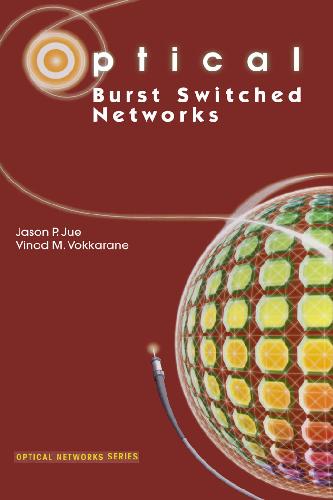Jue J.P., Vokkarane V.M.0387237607
Table of contents :
Team DDU……Page 1
Dedication……Page 6
Table Of Contents……Page 8
List of Figures……Page 12
List of Tables……Page 16
Preface……Page 18
1. INTRODUCTION……Page 20
1.1 Optical Circuit Switching……Page 22
1.2 Optical Packet Switching……Page 23
1.3 Optical Burst Switching……Page 25
References……Page 28
2.1 OBS Network Architecture……Page 30
2.2 Enabling Technology……Page 34
2.3 Physical-Layer Issues……Page 37
References……Page 40
3. BURST ASSEMBLY……Page 42
3.1 Timer and Threshold Selection……Page 43
3.2 Effect of Burst Assembly on Traffic Characteristics……Page 45
3.3 Evaluation of Threshold-Based Burst Assembly Techniques……Page 46
References……Page 54
4.1 Classification of Signaling Schemes……Page 56
4.2 Just-Enough-Time (JET)……Page 61
4.3 Tell-and-Wait (TAW)……Page 63
4.4 Intermediate Node Initiated (INI) Signaling……Page 64
4.5 Analytical Delay Model……Page 69
4.6 Numerical Results……Page 72
References……Page 75
5.1 Optical Buffering……Page 76
5.2 Wavelength Conversion……Page 78
5.3 Deflection Routing……Page 79
5.4 Burst Segmentation……Page 80
5.5 Segmentation with Deflection……Page 85
5.6 Contention Resolution and QoS……Page 95
References……Page 96
6. CHANNEL SCHEDULING……Page 100
6.1 Segmentation-Based Channel Scheduling……Page 105
6.2 OBS Core Node Architecture……Page 107
6.3 Segmentation-Based Non-Preemptive Scheduling Algorithms……Page 108
6.4 Segmentation-Based Non-Preemptive Scheduling Algorithms with FDLs……Page 113
6.5 Numerical Results……Page 117
References……Page 123
7. QUALITY OF SERVICE……Page 126
7.1 Relative QoS in OBS Networks……Page 127
7.2 Absolute QoS……Page 141
References……Page 149
8.1 Labeled OBS……Page 152
8.2 Multicasting in OBS……Page 154
8.3 Protection for Optical Burst-Switched Networks……Page 155
8.4 TCP over OBS……Page 157
8.5 OBS Testbeds……Page 160
References……Page 161
Index……Page 164







Reviews
There are no reviews yet.